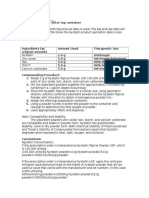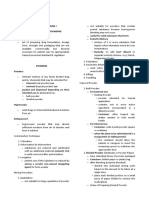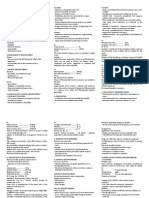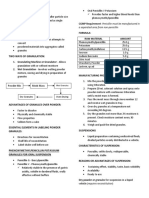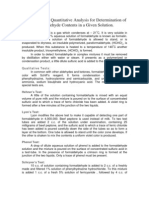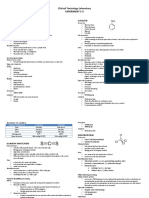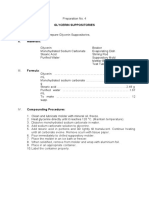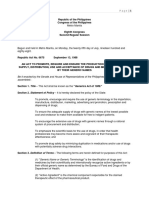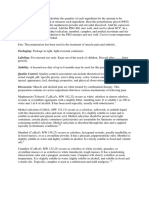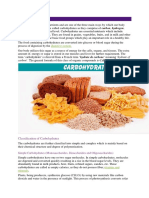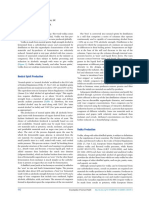Monthlys Prep 1 - 10
Monthlys Prep 1 - 10
Uploaded by
karageeCopyright:
Available Formats
Monthlys Prep 1 - 10
Monthlys Prep 1 - 10
Uploaded by
karageeOriginal Description:
Copyright
Available Formats
Share this document
Did you find this document useful?
Is this content inappropriate?
Copyright:
Available Formats
Monthlys Prep 1 - 10
Monthlys Prep 1 - 10
Uploaded by
karageeCopyright:
Available Formats
Parts of a Prescription 1. Patients Info 2. Superscription Rx symbol recipe, take thou 3. Inscription a.
. Basis active ingredient serves as basis for prescription b. Adjuvant serves to aid the basis c. Corrective used to correct undesirable properties of the basis d. Vehicle 4. Subscription instruction to the pharmacist 5. Transcription signa, instruction to the patient 6. Prescribers Info Beyond Use Date: 1. For non-aqueous liquids and solids not later than 25% of the time remaining until products expiration or 6 months, whichever is less 2. For water containing drugs 14 days at cool temperature 3. Others intended duration of therapy or 30 days; whichever is less POWDERS intimate mixture of dry finely divided drugs or substances that maybe intended for internal use Types of Comminution: a. Trituration use of mortar and pestle; grinding motion b. Pulverization with Intervention use of mortar and pestle; addition of solvent (ex. camphor and alcohol) c. Levigation - addition of non-solvent/levigating agent to form a paste d. Mills and Pulverizer for large production Blending Techniques: a. Spatulation used to blend eutectic mixtures or substances that liquefy b. Trituration c. Geometric dilution used to blend potent substances; diluent is added portion by portion d. Sifting use of a sieve; results to fluffy powder; for non-potent materials e. Tumbling for large scale production Types of Powders: A. Bulk Powder Dusting powder Used in bulk No specific dosage strength For internal (antacids) wide mouth bottle For external use sifter bottle B. Divided Powder With controlled dosage Also called paper tabs, chartulae, powder paper Types of Paper Used: a. Simple Bond Paper No moisture resistance Opaque b. Vegetable Parchment Onion skin, thin semi-opaque paper With limited moisture resistance
c. Glassine Transparent, frosted With limited moisture resistance d. Waxed Transparent Waterproof Methods of Preparation: a. Weighing most accurate; for potent substances b. Block and Divide PRESCRIPTION NO. 1 Therapeutic Use: Antifungal Route of Administration: Topical/External INGREDIENT Salicylic acid Benzoic Acid Camphor Menthol Phenol Starch PHYSICAL CHARACTERISTICS White crystals usually needles/fluffy white pwdr White crystalline flakes White crystals Waxy, clear white crystalline subs. White or clear acicular crystals Irregular, angular white masses or fine pwdr SOLUBILITY Sol. in alcohol, slightly sol. in water Insol. in water Slightly sol. water USE Dermatological problems; analgesic Topical Antiseptic Antimicrobial Cooling effect Antiseptic Filler, Binder
fine
in
Insol. in cold water and alcohol
Procedure: 1. Triturate camphor, menthol and phenol. 2. Add salicylic acid then benzoic acid. 3. Add starch, portion by portion. 4. Pass through sieve #40. Incompatibility: Eutectic Mixture of Camphor and Menthol Remedy: Add phenol. PRESCRIPTION NO. 2 Therapeutic Use: Antifungal Route of Administration: Topical/External INGREDIENT Calamine powder Camphor Talc Starch PHYSICAL CHARACTERISTICS Pink pwdr White crystals Very fine, white crystalline pwdr Irregular, angular white masses or fine pwdr SOLUBILITY USE Antipruritic Antimicrobial Filler, diluent Stabilizer, Filler, Binder
Insol. in water Insol. in cold water and alcohol
Procedure: 1. Triturate camphor in 1 drop of alcohol. (Pulverization with intervention) 2. Add calamine, starch and talc.
3.
Pass through sieve #40. Nystatin: 1 : 10 = x : 20 x = 2 g nystatin
Equal quantities to give 20 g
Computations: Camphor0.08 parts Calamine pwdr..8 parts Starch.9.2 parts Talc.30 parts 0.08 parts: total parts = x : 10 g 0.08 parts camphor : 47.28 parts = x : 10 g x = 0.0169 g camphor 8 parts calamine : 47.28 parts = x : 10 g x = 1.69 g calamine powder 9.2 parts starch : 47.28 parts = x : 10 g x = 1.95 g starch 30 parts talc : 47.28 parts = x : 10 g x = 6.35 g talc PRESCRIPTION NO. 3 Therapeutic Use: Antifungal Route of Administration: Topical/External INGREDIENT Nystatin Zinc Oxide Talc Starch Calcium carbonate Nystatin: Nystatin Powder, USP Pure Nystatin (4,400 units/milligram) Nystatin Topical Powder, USP 100,000 units/gram Market: Nystatin Drops 100,000/gram Procedure: 1. Triturate zinc oxide, talc, starch and calcium carbonate. 2. Add #1 to nystatin portion by portion. Method of Preparation: Geometric Dilution Computations: Conc. of nystatin in powder = usual conc. x amount of nystatin/total g pwder ex. 100,000 units/g x 2 g nystatin/22 g powder = 9090.91 units/g 4,400 units/mg x 2000 mg/22000 mg = 400 units/mg Nystatin pwdr 1:10 w/ the ff. Zinc oxide Talc Starch Calcium carbonate PHYSICAL CHARACTERISTICS SOLUBILITY USE Antifungal Adsorbent/Astringent Filler, diluent Stabilizer, Filler, Binder Adsorbent/Astringent
20 g / 4 ingredients = 5 g per ingredient PRESCRIPTION NO. 4 Therapeutic Use: Antacid Route of Administration: Oral INGREDIENT Magnesium trisilicate Chalk Heavy magnesium carbonate Sodium bicarbonate PHYSICAL CHARACTERISTICS Fine, white, odourless, tasteless pwdr White crystalline pwdr USE Antacid Adsorbent, Antacid Antacid Antacid
White crystalline pwdr
Procedure: 1. Triturate Mg trisilicate. Set aside 2. Triturate chalk. Set aside 3. Triturate heavy magnesium carbonate. Set aside 4. Triturate sodium bicarbonate. Set aside. 5. Mix all ingredients. Triturate. 6. Pass through sieve #20. PRESCRIPTION NO. 5 Therapeutic Use: Antacid Route of Administration: Oral INGREDIENT Aluminum hydroxide Magnesium trisilicate Peppermint oil Calcium carbonate PHYSICAL CHARACTERISTICS Fine, white, odourless, tasteless pwdr USE Antacid Antacid Fragrant Antacid, Adsorbent
Very fine, white crystalline pwdr Irregular, angular white masses or fine pwdr
Insol. in cold water and alcohol
Procedure: 1. Triturate aluminium hydroxide using geometric dilution. 2. Add magnesium silicate 3. Add calcium carbonate 4. Add peppermint oil until desirable scent. 5. Mix. PRESCRIPTION NO. 6 Therapeutic Use: Heart failure and arrhythmia Route of Administration: Oral Ingredient: Digoxin Used for heart failure and arrhythmia
From Digitalis purpurea Available in: 250 mcg tablet, 2 mL ampule/vial (250 mcg/mL), 60 mL pediatric elixir (50 mcg/mL)
Procedure: 1. Crush and triturate tablet. 2. Weigh. PRESCRIPTION NO. 7 Therapeutic Use: Analgesic, Anti-inflammatory, Antithrombotic Route of Administration: Oral Ingredient: Aspirin Used as analgesic, anti-inflammatory, antithrombotic Antithrombotic: 75 100 mg OD Anti-inflammatory, Analgesic, Antipyretic: 300 900 mg every 4 to 6 hours Maximum dose: 4 g/ day Procedure: 1. Crush and triturate tablet. 2. Block and divide. PRESCRIPTION NO. 8 Therapeutic Use: Antibiotic Route of Administration: Oral Ingredients: Sulfadiazine Available in 500 mg tablet or 7.7 gr Antibiotic Sodium Bicarbonate Increases solubility of sulfadiazine Lactose Diluent if amount of the AI is less than 2 gr or 130 mg Corrective if amount of AI is greater than 2 gr or 130 mg As corrective, amount of lactose is equal to amount of the AI Procedure: 1. Crush and triturate the tablet. 2. Add sodium bicarbonate and triturate. 3. Add lactose and triturate. 4. Block and divide. PRESCRIPTION NO. 9 Therapeutic Use: Antibiotic Route of Administration: Oral Ingredients: Sulfadiazine
Available in 500 mg tablet or 7.7 gr Antibiotic Sodium Bicarbonate Increases solubility of sulfadiazine Acetylsalicylic acid Antipyretic, Anti-inflammatory, Analgesic To prevent gummy mass or hydrolyzation of ASA, double wrap the prep. Procedure: 1. Triturate each ingredient separately. 2. Mix the powder by spatulation. Incompatibility: ASA and Sodium bicarbonate form a mass Remedy: Do not triturate. Use spatulation method. PRESCRIPTION NO. 10 Therapeutic Use: Anticonvulsant Route of Administration: Oral Ingredients: Carbamazepine Used as anticonvulsant Even in solid dosage forms, it has stability problems Decreased bioavailability caused by tablet hardening Should be kept in a tightly closed container because it becomes dehydrated when exposed to moisture, decreasing its bioavailability Recommended dose: 5 20 mg/kg.day Lactose Diluent Procedure: 1. Triturate carbamazepine tablet and put in 30 mg packet. 2. Add lactose to make 300 mg. 3. Weigh to check final weight. Computations: Carbamazepine 100 mg/powder packet 100 mg carbamazepine + diluent (lactose) = 300 mg powder packet Diluent = 200 mg lactose 100 mg packet = 100 mg/dose Sig.: Take 1 pwdr packet q.i.d, p.c. & h.s. Determine the prescribed dose (mg/kg/day) a. 35 lbs patient 35 lbs x 1kg/2.2 lbs = 15.91 kg 100 mg/dose x 4 doses per day = 400 mg/day 400 mg per day / 15.91 kg = 25 mg/kg/day OVERDOSED Amount of carbamazepine : 30 mg per packet Available strength: 200 mg/tab Ave wt./tab = 280 mg 200 mg : 280 mg/tab = 30 mg per packet : x x = 42 mg crushed carbamazepine pwdr per pwdr pocket
You might also like
- Edexcel IAL Biology Unit 3 All Core Practicals (ReallyAcademics)Document67 pagesEdexcel IAL Biology Unit 3 All Core Practicals (ReallyAcademics)Will Andy100% (3)
- Dispensing Lab - RX 1-13 NotesDocument7 pagesDispensing Lab - RX 1-13 NotesEdrick Ramoran60% (5)
- Drug Utilization Review: Worksheet ScoreDocument30 pagesDrug Utilization Review: Worksheet ScoreRaizane Sky PalecNo ratings yet
- PHA6111 Lab ACTIVITY 2 HERNANDEZDocument4 pagesPHA6111 Lab ACTIVITY 2 HERNANDEZGrace HernandezNo ratings yet
- Dds Laboratory Preparation 2: Magnesium Citrate Oral SolutionDocument4 pagesDds Laboratory Preparation 2: Magnesium Citrate Oral SolutionKate MendozaNo ratings yet
- Dispensing2 Lab - RX 7-12Document3 pagesDispensing2 Lab - RX 7-12Alyssa Erika AzoresNo ratings yet
- Chapter 1-3 LectureDocument9 pagesChapter 1-3 LectureAnalizaNo ratings yet
- Preparation #: Paracetamol Tablets I. Objectives:: Pharmaceutical Dosage Forms Laboratory ManualDocument2 pagesPreparation #: Paracetamol Tablets I. Objectives:: Pharmaceutical Dosage Forms Laboratory Manuallalag yanNo ratings yet
- RX 1 10Document9 pagesRX 1 10Mich Tolentino0% (1)
- PHA6111LAB - Finals ReviewerDocument7 pagesPHA6111LAB - Finals ReviewerMarie Eloise BugayongNo ratings yet
- Pharm. Chem. - 2 Lab Exp No 5Document3 pagesPharm. Chem. - 2 Lab Exp No 5davenNo ratings yet
- IncompatibilitiesDocument1 pageIncompatibilitiesIan GabritoNo ratings yet
- Pharmaceutical IncompatibilitiesDocument7 pagesPharmaceutical IncompatibilitiesamrhkmhNo ratings yet
- Experiment P'ceuticsDocument4 pagesExperiment P'ceuticsnigamnirupam50% (2)
- 02 Preparation 1 and 2Document4 pages02 Preparation 1 and 2James AzurinNo ratings yet
- Dispensing Post LabDocument3 pagesDispensing Post LabYanni Bryan RegaladoNo ratings yet
- Pharmaceutical Manufacturing Lecture Tablets & Tablet CoatingDocument14 pagesPharmaceutical Manufacturing Lecture Tablets & Tablet CoatingDaena TimtimanNo ratings yet
- Activity 7 Calculations Involved in Parenteral Therapy: University of Santo TomasDocument3 pagesActivity 7 Calculations Involved in Parenteral Therapy: University of Santo TomasJANNIE BELLE RODRIGUEZ100% (1)
- Drug Incompatibilities and InteractionDocument3 pagesDrug Incompatibilities and Interactiontho27930% (1)
- Practical Exam Prescriptions PDFDocument5 pagesPractical Exam Prescriptions PDFMich Tolentino100% (2)
- Isotonic and Buffer SolutionsDocument63 pagesIsotonic and Buffer SolutionsShailu Gracie BalacuitNo ratings yet
- Dr. Nelson T. TubonDocument29 pagesDr. Nelson T. TubonBS50% (2)
- Community Pharmacy Intern Exercises5-9Document6 pagesCommunity Pharmacy Intern Exercises5-9Joslin RozNo ratings yet
- In Komp A Tibi LitasDocument54 pagesIn Komp A Tibi LitasHifi Rizki.RNo ratings yet
- Physical PharmacyDocument47 pagesPhysical PharmacyRozamae MagnanaoNo ratings yet
- Exercises 8-10 (By Dr. N. Tubon) PDFDocument25 pagesExercises 8-10 (By Dr. N. Tubon) PDFLoren100% (1)
- Activity 7 DISPENSING PRICE With AnswersDocument3 pagesActivity 7 DISPENSING PRICE With AnswersChristine DelmendoNo ratings yet
- Phar 6 NotesDocument4 pagesPhar 6 NotesAlexandra GarciaNo ratings yet
- Finals-Alkaloids and VitaminsDocument8 pagesFinals-Alkaloids and VitaminsLeah Lyn Candog ZitaNo ratings yet
- IncompatibilityDocument8 pagesIncompatibilitypoonamNo ratings yet
- UST Pharmaceutical Laboratory White LabelDocument1 pageUST Pharmaceutical Laboratory White LabelEarl Cedric DL DalmacioNo ratings yet
- Hospital Pharmacy LabDocument179 pagesHospital Pharmacy LabJohn Carlo Cabueñas RagmaNo ratings yet
- DISPLABPreps1 20 2Document21 pagesDISPLABPreps1 20 2Alexa Joy C. InguilloNo ratings yet
- Formaldehyde in SolutionsDocument2 pagesFormaldehyde in SolutionsGAMalik100% (2)
- Brex Manufacturing EditedDocument291 pagesBrex Manufacturing EditedMing MingNo ratings yet
- FARM Note CarePlansDocument11 pagesFARM Note CarePlansbrain bareNo ratings yet
- ToxiiiiiiDocument6 pagesToxiiiiiiRaya Ibarra LumogdangNo ratings yet
- Midterm DDS Lab Activity 2 - Group 01Document6 pagesMidterm DDS Lab Activity 2 - Group 01Omie PumbybyNo ratings yet
- Experiment No 3Document3 pagesExperiment No 3April Mergelle Lapuz20% (5)
- DispensingDocument12 pagesDispensingKitkat CasacopNo ratings yet
- Quality Control of Tablets Lecture 1Document15 pagesQuality Control of Tablets Lecture 1Muhammad AzeemNo ratings yet
- Cold Cream USPDocument4 pagesCold Cream USPRon OlegarioNo ratings yet
- Incompatibilities Ver 02 PDFDocument17 pagesIncompatibilities Ver 02 PDFNot JordanNo ratings yet
- Generics Act of 1988Document5 pagesGenerics Act of 1988JIEZFANo ratings yet
- Topical AgentsDocument5 pagesTopical AgentsFemina Argonza100% (1)
- Gastrointestinal and Hepatobiliary SystemDocument11 pagesGastrointestinal and Hepatobiliary SystemRhealyn LegaspiNo ratings yet
- CardiovascularDocument1 pageCardiovascularMikaela LaoNo ratings yet
- Aspirin ExpDocument4 pagesAspirin ExpLyrojen Mae TorralbaNo ratings yet
- Comp&Disp 3Document14 pagesComp&Disp 3kakak zea100% (1)
- Pharmaceutical IncompatibilityDocument4 pagesPharmaceutical IncompatibilityAsif Hasan NiloyNo ratings yet
- Preparation OintmentDocument1 pagePreparation OintmentLyanlie MinamotoNo ratings yet
- Pha6111 Dispensing Lab Customer Service PDFDocument5 pagesPha6111 Dispensing Lab Customer Service PDFKATHLEEN CALALANGNo ratings yet
- Preparation # I. Objectives:: Pharmaceutical Dosage Forms Laboratory ManualDocument2 pagesPreparation # I. Objectives:: Pharmaceutical Dosage Forms Laboratory Manuallalag yanNo ratings yet
- G5 Dispensing LectureDocument20 pagesG5 Dispensing LectureCristine LalunaNo ratings yet
- New Drug Development and Approval ProcessDocument19 pagesNew Drug Development and Approval ProcessKristine Aubrey AlvarezNo ratings yet
- Ra 9711Document15 pagesRa 9711Johnny ManahanNo ratings yet
- Post Lab Qc1 2019Document42 pagesPost Lab Qc1 2019Frances SaludNo ratings yet
- Assignment 1 Prescription Analysis and InterpretationDocument4 pagesAssignment 1 Prescription Analysis and InterpretationShannen CostoNo ratings yet
- Phardose Lab (Prep 6-10)Document3 pagesPhardose Lab (Prep 6-10)Jan Aira Almazan100% (1)
- POWDERSDocument6 pagesPOWDERSsyedamaryamali19No ratings yet
- F&IP Lab Manual 4th YearDocument173 pagesF&IP Lab Manual 4th YearVargheseNo ratings yet
- CarbohydratesDocument5 pagesCarbohydratesAmita RaoNo ratings yet
- Vodka: RI Aylott, Aylott Scientific, Dunblane, UKDocument4 pagesVodka: RI Aylott, Aylott Scientific, Dunblane, UKFer ChicoNo ratings yet
- Sweet Potato PowderDocument45 pagesSweet Potato PowderHoàng Nguyễn VănNo ratings yet
- 1 34Document34 pages1 34hhedfiNo ratings yet
- Study Rate: Chemistry Notes For Class 12 Chapter 14 BiomoleculesDocument21 pagesStudy Rate: Chemistry Notes For Class 12 Chapter 14 BiomoleculesYASH SONARNo ratings yet
- Lagundi (Vitex Negundo) Spray Dried Extract1Document6 pagesLagundi (Vitex Negundo) Spray Dried Extract1Charmaine GarcesNo ratings yet
- Chemistry Project On Digestion of Starch Class 12Document13 pagesChemistry Project On Digestion of Starch Class 12Shaik FaisalNo ratings yet
- Starch Booklet 2013Document42 pagesStarch Booklet 2013Amelya Nurlaelaa ShariiNo ratings yet
- Momigami WebDocument45 pagesMomigami WebDomi GalloNo ratings yet
- The Cassava Value Chain in MozambiqueDocument77 pagesThe Cassava Value Chain in MozambiqueMarcio SitoeNo ratings yet
- Analysis of Fruit JuiceDocument14 pagesAnalysis of Fruit JuiceAKSHAY SAHU 12ANo ratings yet
- Biochemlab (Lipids)Document18 pagesBiochemlab (Lipids)Apple Bottom JeansNo ratings yet
- CBLM - Cok - Prepare StarchDocument49 pagesCBLM - Cok - Prepare Starchmary ann coperNo ratings yet
- Activity 4 Carbohydrates: Specific Reactions I. CarbohydratesDocument7 pagesActivity 4 Carbohydrates: Specific Reactions I. CarbohydratesAlih KathlyannNo ratings yet
- Britannia SIPDocument43 pagesBritannia SIPArup ChakrabortyNo ratings yet
- Uofc Gob05b LabDocument12 pagesUofc Gob05b LabSridevi sNo ratings yet
- B2 Revision Booklet NewDocument9 pagesB2 Revision Booklet NewRohoNo ratings yet
- GSA BiomoleculesDocument12 pagesGSA BiomoleculesNimra FirdousNo ratings yet
- Cooking Shapes The Structure and Function of The Gut MicrobiomeDocument29 pagesCooking Shapes The Structure and Function of The Gut MicrobiomeMemphisIglesiasNo ratings yet
- Sweet Potato Review of Related LiteratureDocument6 pagesSweet Potato Review of Related Literatureafmzndvyddcoio100% (1)
- Cereal Grains NotesDocument6 pagesCereal Grains Notesjellyn.lai.owoNo ratings yet
- Starch Sector Report - AASPL - 23-07-10Document15 pagesStarch Sector Report - AASPL - 23-07-10DFrancis007No ratings yet
- Optimization of Mashing Process in Beer Production Using RiceDocument4 pagesOptimization of Mashing Process in Beer Production Using Rice_juliogsNo ratings yet
- Study Material Practical Manual Fundamental of Plant Biochemistry BiotechnologyDocument47 pagesStudy Material Practical Manual Fundamental of Plant Biochemistry BiotechnologySanket kharsadeNo ratings yet
- Kinetic Analysis of Amylase Using Quantitative BenDocument4 pagesKinetic Analysis of Amylase Using Quantitative BenCarlin NauNo ratings yet
- Dynamic Rheology of StarchDocument10 pagesDynamic Rheology of StarchRicardo Abi ZeidNo ratings yet
- Cereals and Starch Cookery g10Document26 pagesCereals and Starch Cookery g10alcon moistNo ratings yet
- Kertas 3 Pep Pertengahan Tahun Ting 5 Terengganu 2013Document9 pagesKertas 3 Pep Pertengahan Tahun Ting 5 Terengganu 2013vonashNo ratings yet
- Multifaceted Role of Carbohydrates in PlantsDocument2 pagesMultifaceted Role of Carbohydrates in PlantsAcerfadli FadliacerNo ratings yet








